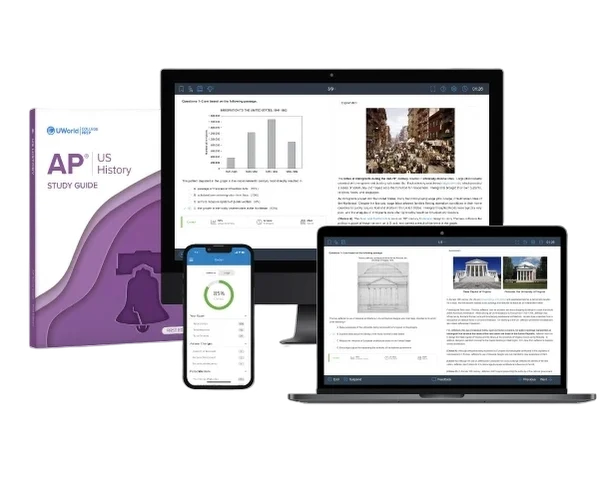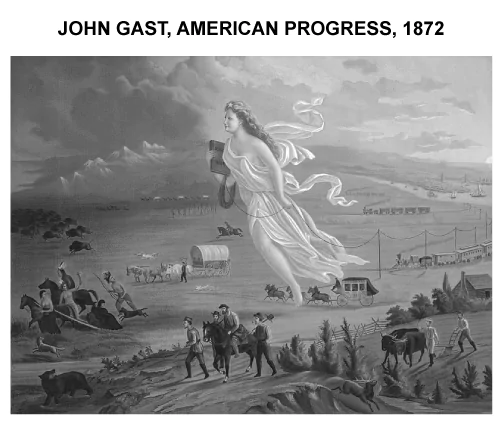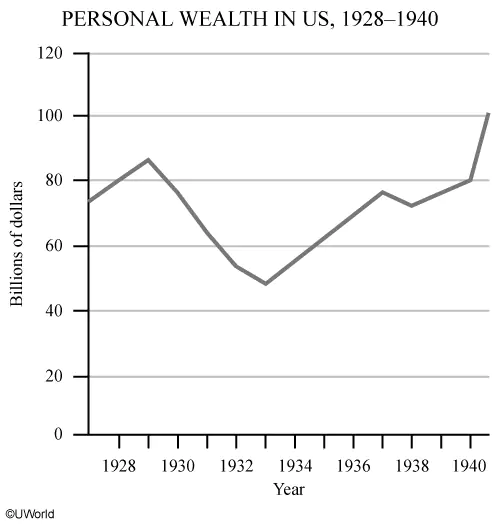Mastering the APUSH SAQs is crucial for achieving a high score, yet it is often overlooked when preparing for the exam. The SAQ section is worth 20 percent of your overall exam grade—that’s more than the long-essay question.
The good news is that the SAQ section is considered the most straightforward section of the test. That does not imply it is easy. AP U.S. History short-answer questions do not simply ask you to regurgitate names and dates. They assess your historical reasoning and require you to cite evidence to support a historical claim.
You must understand the types of SAQs on the APUSH exam to achieve a high score. You'll also need to learn how to answer the questions in a way that will earn you credit. Plus, you'll need to be able to answer the questions within the allotted time.
Format of AP U.S. History SAQ Section
On the AP U.S. History exam, the first free response questions you will answer are the short answer questions. You’ll have 40 minutes to complete this section of the exam and should spend approximately 15 minutes on each question (5 minutes on each subpart).
All APUSH short-answer questions are divided into three parts. Each SAQ should be between two and three sentences long. You must compare, describe, evaluate, explain, identify, or support an argument.
Question 1 (required) will be based on paired secondary sources from prominent or influential historians. The passages will present different interpretations of historical developments or processes between 1754 and 1980.
Question 2 (required) will be based on a primary source and require you to explain a historical development or process between 1754 and 1980. The source could be a passage, data, or visual source.
After completing the required questions, you may choose between two non-stimulus questions. One question focuses on early American history between the years 1491 and 1877, while the other question focuses on the years between 1865 and 2001.
How To Write An SAQ APUSH
Remember, APUSH short-answer questions are not essays, and unlike DBQs and LEQs, there is no need for a thesis statement; simply answer the prompt. Answering an SAQ requires you to be brief, yet you also need to give enough details to answer all parts of the prompt. Bulleted lists are not acceptable, so try to provide a straightforward answer in complete sentences.
For an "identify" or "describe" prompt, you’ll need to give and support a simple answer with evidence. Then "explain" or "expand" your claim by connecting your evidence to the original prompt to support it.
A useful strategy is the A.C.E. method: answer, cite evidence, and explain. Therefore, respond directly to the question in a complete sentence and avoid restating the prompt. Next, cite evidence that supports your answer. Lastly, provide an explanation or additional context to ensure you have completely answered the question.

AP U.S. History short-answer questions (SAQ) examples
Knowing what to expect is the first step to achieving a perfect score on the APUSH SAQ section. Here are APUSH SAQ examples of the basic question types you will encounter in this section.
Secondary Source Question (required)
SAQ Example 1
"The New Deal economic policies ... implanted several ‘stabilizers' that have been ... successful in averting another such depression. ... Such safeguards restored confidence in the discredited banking system and established a firm economic foundation that performed well for decades thereafter. The New Deal was also responsible for numerous other notable changes in American life. In the space of a decade government laws eliminated sweatshops, severely curtailed child labor, and established enforcement standards for hours, wages, and working conditions. ... The New Deal's safety net ... firmly established the principle that the government had an obligation to assist the needy."
Roger Biles, historian, 1991
"My principal problem with Roosevelt and the New Deal [is] not over specific reforms or his social programs, but with the failure of the United States to recover from the depression during the eight peacetime years that he and his policies governed the nation. ... There were certainly positive contributions under the New Deal, but they may not have outweighed the negative aspects of the period. When one examines the full range of New Deal proposals ... the outline emerges of a form of government alien to any definition of liberalism except that of New Dealers themselves. Historians need to weigh more thoroughly and objectively the implications for the United States if Roosevelt's programs had been fully implemented. They also need to assess the costs in human misery of the delay in recovery, and of reduced U.S. influence abroad at a critical time in world affairs owing to its economic prostration."
Gary Dean Best, historian, 1990
Using the excerpts above, answer (a), (b), and (c).
- Briefly explain ONE major difference between Biles's and Best's historical interpretations of the New Deal.
- Briefly explain how ONE specific historical event or development during the period 1932 to 1980 that is not mentioned directly in the excerpts could be used to support Biles's interpretation.
- Briefly explain how ONE specific historical event or development during the period 1932 to 1980 that is not mentioned directly in the excerpts could be used to support Best's interpretation.
Source: 2016 Administered test
Non-stimulus question
SAQ Example 2
Answer (a), (b), and (c).
- Briefly explain why ONE of the following was the most significant factor in the failure of Reconstruction.
- Economic factors
- Political factors
- Societal factors
- Provide ONE example of a specific historical event or development that supports your explanation in (a).
- Provide specific historical evidence for why ONE of the options is less convincing than your choice in (a) as the most significant factor in the failure of Reconstruction.
Exemplar:
- The societal backlash from white Southerners against African Americans' civil rights following the Civil War made Reconstruction's failure inevitable. This is supported by over a century of continued efforts during and following Reconstruction in Southern states to reverse African American gains and keep African American society separate from and inferior to Southern white society.
- White Southerners established militia groups, such as the Ku Klux Klan, that maintained white supremacy by terrorizing and lynching African Americans during Reconstruction. The violence was so severe that in 1870 President Grant signed the Enforcement Acts to help end the violence against African Americans.
- Political factors make for a less convincing argument than societal factors because white southerners used violence to reverse political gains of African Americans. For example, despite the political success of the 14th and 15th Amendments that constitutionally protected African Americans' civil rights, racial violence reinforced white superiority, and voter intimidation kept African Americans from exercising their political rights.
Primary source question (art)
SAQ Example 3
Using the image above, which depicts the United States in the nineteenth century, answer (a), (b), and (c).
- Briefly explain ONE historical perspective expressed in the image.
- Briefly explain how ONE specific event or development in the period from 1865 to 1877 contributed to the process depicted in the image.
- Briefly explain ONE specific historical effect in the period from 1877 to 1898 that resulted from the process depicted in the image.
Exemplar:
- The image illustrates the various ways in which America's Manifest Destiny is being fulfilled. For example, the railroad is expanding westward, farmers are seeking land and opportunity, and technological innovations such as the telegraph follow. The progress of the East, shown by cities, bridges, and boats, is spreading west.
- The transcontinental railroad facilitated westward expansion. Faster transportation of people and goods allowed population centers to be established in the West and contributed to the rapid expansion of American settlement.
- As Americans moved westward to fulfill America's Manifest Destiny, Native Americans were displaced from their traditional homelands. In the late 19th century, Native resistance to westward expansion led to conflict with US troops. By 1890, the westward expansion of US settlement forced many American Indian nations onto reservations and led to significant declines in the Native way of life.
Data driven questions
SAQ Example 4
In your responses, be sure to address all parts of the questions you answer. Use complete sentences; an outline or bulleted list alone is not acceptable.
Using the chart above, answer (a), (b), and (c).
- Briefly explain ONE specific historical event or development that accounts for changes in the personal wealth of Americans between 1929 and 1933.
- Briefly explain ONE specific historical event or development that accounts for changes in the personal wealth of Americans between 1933 and 1940.
- Briefly explain a SECOND specific historical event or development that accounts for changes in the personal wealth of Americans between 1933 and 1940.
Exemplar:
- The stock market collapse of 1929 accounts for a change in personal wealth shown on the graph. Because the stock market lost half its value in three months, personal wealth drastically declined, since the resulting bank failures and business closings left millions with no savings or jobs.
- The Public Works Administration accounted for a change in personal wealth shown on the graph. The PWA oversaw billions of dollars used to employ millions of people on federal relief. These federal government jobs reduced unemployment and increased personal wealth.
- The Works Progress Administration accounted for a change in personal wealth shown on the graph. The WPA allocated billions of dollars for private businesses to build roads, bridges, hospitals, and other public works projects, which put over 5 million people back to work.
How Can I Practice AP U.S. History Short Answer Questions?
Achieving a score of 5 on the APUSH exam requires mastery of the SAQ section. Practicing short-answer questions is also a great way to review content and practice timed writing.
It is important that you work on APUSH practice SAQs that are similar to those asked on the exam. Also, practice the secondary source questions the most, as they will always appear on the SAQ portion of the APUSH examination.
Many of the SAQs from past exams are no longer relevant due to the massive exam revision that began in 2017. As a result of this restructuring, the course no longer covers content before 1200.
Sign up for UWorld’s APUSH course to access a full study guide plus an extensive QBank to master every concept on the exam.

Frequently Asked Questions (FAQs)
How are AP U.S. History short-answer questions (SAQ) graded?
The short-answer section of the APUSH exam consists of three questions, each of which can receive 0 to 3 points. Each part of the SAQ is worth a point. In total, 9 points are possible, and each point is earned independently.
When the section is scored, College Board graders will determine if each part of your SAQs earned a point or not. Here are the criteria for earning points on SAQs:
- Clarity. You must clearly communicate your answer to receive a point.
- Accuracy. The answer must be historically defensible.
- Description. You must include relevant information that describes the historical process or development.
- Explanation. You must provide insight into historical development or explain relevant historical relationships.
What score do I need on the SAQ section to pass the exam?
How long is the short answer section of the AP U.S. History exam?
Where can I get short-answer questions from past AP U.S. History exams?
References
- (2024). Section I, Part B: Short Answer. Exam Format. AP United States History. Retrieved on March 21, 2024 from https://apcentral.collegeboard.org/courses/ap-united-states-history/exam
Read More Related Articles
Looking for an easy-to-read AP U.S. History exam format? Discover the exam format in this simple guide that breaks down the exam components, question types on the exam, and more!
AP U.S. History Course and Exam DescriptionThe CED PDF from the College Board can be overwhelming. Here is a summary of all the units, topics, and key concepts you need in the AP U.S. History Course and Exam Description.
How to Answer AP U.S. History FRQStruggling with AP U.S. History Free Response Question (FRQs)? Discover sample FRQs and expert strategies from UWorld to help you master this challenging exam section!
How to Self-study for AP U.S. HistoryLearn effective tips and strategies to self-study for the AP U.S. History exam. Build confidence, master core concepts, and achieve a high score independently too.
Best AP U.S. History Study Guide ComparisonDiscover expert insights into Kaplan, Barron's, Princeton Review, and UWorld. Learn how each resource compares to help you choose the best fit.
Best AP U.S. History Prep Course ReviewWondering which AP U.S. History prep course is the best? Check out this detailed review to find the right course for your exam prep.






